AR Inquiry
The AR Inquiry tab allows you to access and print AR ledgers and histories to give you a complete and current picture of the account. This information includes a chronological listing of every transaction for an account, sorted by accounting period or date, showing each sale, credit or adjustment, and each payment and when it was applied.
Using the Filters, inquiries can be made across all the AR accounts based on your specific parameters. For example, a report can be generated that list regular invoices (transaction code 03) for a particular time-frame (Post Month/Year).
Entering different search parameters in the Filters tab can take you to different parts of the AR Inquiry screen. For example:
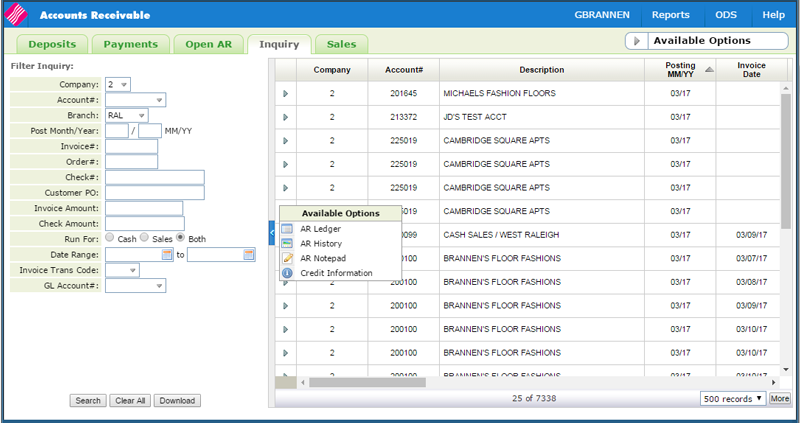
Printing AR inquiry Information
AR Ledger
From this window, you can find each account's current balances as well as aging and all open transactions, or those paid or closed in the current month.
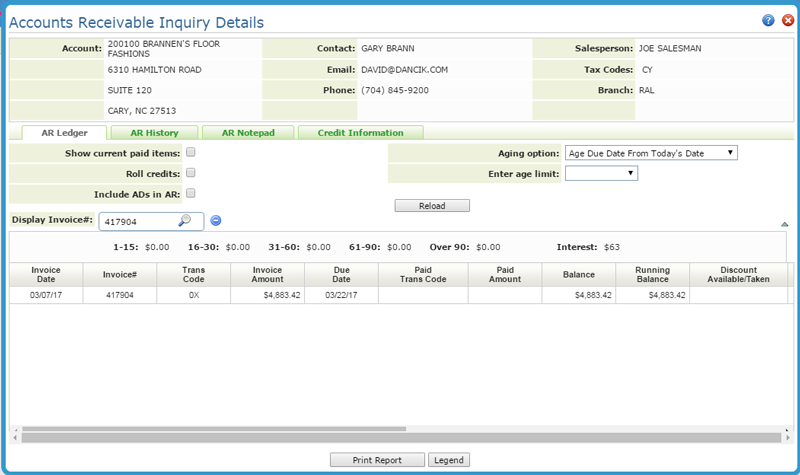
Use options in the middle of the screen to further refine the search.
- Show Current paid items - Activating this option will include all invoices that have been paid in the current month. If it is not activated paid invoices are not displayed.
- Aging Option - The default aging option is set the Company Settings File (SET 3). You can override it to view the AR Ledger via other aging options. One of the options must be selected as the default aging option for each company number. All aging screens and reports will use the default option unless an aging option is displayed. In that case. you can select one of the four options for that particular report or screen.
- Roll credits - All unapplied credits (except advance deposits) are rolled forward over the oldest open debits. In other words, a credit, regardless of date, will apply the oldest open debits for the purpose of the aging. If there are no open debits to which to apply, unapplied credits will show in the Current category.
- Enter Age Limit - The age limits are over 15 days, over 30 days, over 60 days, over 90 days, a blank field will display all open AR transactions (this is the default). If the selected aging option ages based on invoice dates, then the age limits are based on invoice dates. If the selected aging option ages based on due dates, then the age limits are also based on due dates.
- Include AD's in AR - Activating this option includes advance deposits on all AR ledgers and reports. Unless advance deposits are tracked separately it is recommend that you activate this option. Not activating this option means all aging screens and reports omit advance deposits from totals. The system assumes that you have a liability account labeled Advance Deposits From Customers in your General Ledger, and that you will maintain this G/L balance on a monthly basis. The default for this setting is made in the Company Settings File (SET 3).
Options Age Invoice Date from Today's Date and Age Invoice Date from Last EOM Date age according to how old the invoice is. In other words, Over 30 means it is between 31 and 60 days past the invoice date. Options 1 and 2 do not consider the terms due date. Options 3 and 4 age according to the terms due date. In other words, over 30 means it is between 31 and 60 past the due date.
The current date is today's date according to the computer's calendar and clock, except during EOM processing, at which time all AR aging reports use the EOM date as the current date for aging. This is done to allow for closing the month earlier or later then the actual last day of the month. Aging options 2 and 4 use the last EOM date for aging at all times, not just at EOM.
If current date is 12/31/09, the aging is Over 60=150.00 (the 100.00 credit rolled over the $250.00 debit leaving only the balance of $150.00 in Over 60) if no rolling of credits was done, the aging would be Over 60=$250.00 and Current = <100.00>.
If you do not choose to roll credits, they are aged the same as debits, except for advance deposits which are always shown in the Current column.
AR History
In the Company Settings File (SET 3), you can set the AR History File to store between one and 99 months of history, but the default is set at 24 months. We recommend a 24-month history unless you have enough free disk space to handle more. Also, note that the AR End-of-Month Close final step, Reset Files and Officially End EOM removes old history records. Open transactions are not affected, regardless of their age.
AR Inquiry Notepad
The Notepad window is used for storing notes, comments and other text related to a specific accounts receivable account.

Every entry into the Notepad is time stamped. The format of the time stamp varies depending on the type of web browser you are using. If you are using any browser other than Internet Explorer (IE) 8, the time stamp includes a GMT element (14:14:22 GMT-0500 (Eastern Standard Time)). The IE 8 web browser does not include the GMT information in the time stamp (14:10:23 EST).
Users have to be given permission to update the notepad through the setting Allow User to Update the Notepad in option GL 301.
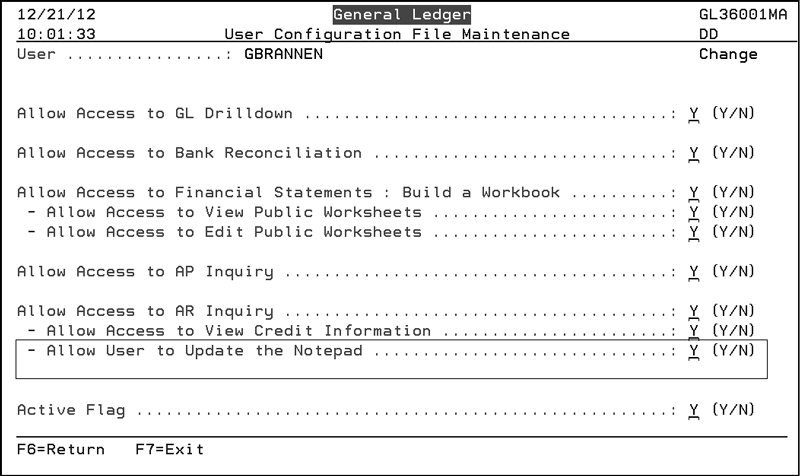
Credit Information
This window shows the amount of credit currently available to an account and the amount an account is over its credit limit, if any. The information is pulled from the AR and Open Order systems.
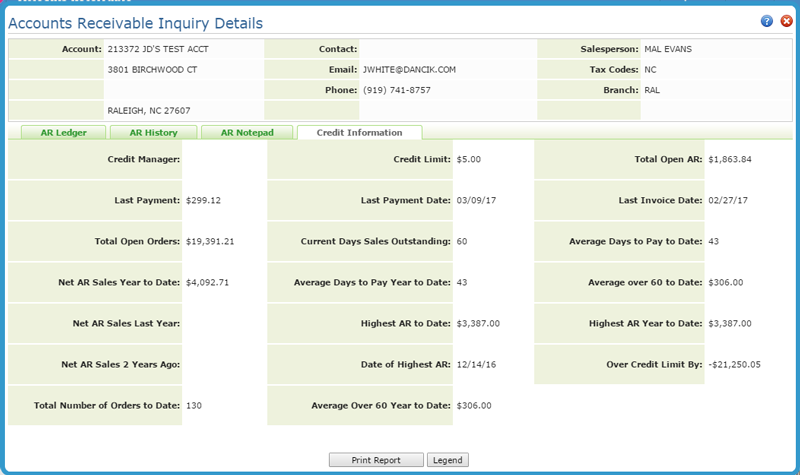
| Field | Description |
|---|---|
| Credit Limit |
The total open orders amount established for a customer. |
| Total Open A/R | The total current accounts receivable balance for this account. |
| Last Payment Date | The date the last payment was received for this account. |
| Last Invoice Date | The date of the last invoice issued for this account. The last check number and payment amount are updated every time a quick deposit or cash application is posted. |
| Total Open Orders | The total open orders for this account, including back orders. Open orders are orders not yet invoiced. |
| Curr Days Sales Outst | Current open A/R divided by average sales per day for this account. Average sales per day is the customer's sales during the past 90 days divided by 90. In the middle of a month, average sales per day also considers the current month to date. For example, on the 15th of each month, the system divides the last 105 days sales by 105. This statistic is informative, because it relates open A/R to sales volume. Customers with a higher current days sales outstanding might be greater credit risks than customers who owe more total dollars. This information is also available in the Customer Sales and Payment Analysis Report. |
| Avg Days To Pay To Date | The average number of days it takes this account to pay an invoice since the account was opened. This figure is updated as each payment is applied to the invoices. |
| Average Over 60 to Date | The average amount over 60 days overdue in the current fiscal year. This figure is updated at the end of each month. |
| Net A/R Sales Last Yr | Total sales posted to A/R during the previous fiscal year, including all computer-generated invoices and manual sales. |
| Highest AR To Data | The highest amount this account has ever owed since it was opened. |
| Highest AR Year to Date | The highest amount this account has owed this fiscal year. |
| Net A/R Sales 2 Years Ago | Total sales posted to accounts receivable during the year before the previous fiscal year, including all computer-generated invoices and manual sales. |
| Date of Highest A/R | The date related to the highest A/R to date. |
| Over Credit Limit by | Amount over the established credit limit. |
| Total Number of Orders To Date | Total number of orders processed for this account since this account was entered into this file. |
| Avg Over 60 To-Dt | The average amount owed over 60 days overdue since this account was opened. This figure is updated at the end of each month. |
Printing AR inquiry Information
Each of the four AR Inquiry tabs has a Print Report button that prints information specific to the related tab.

- The first step after clicking Print Report is to give the report a File Name.
-
Click Continue to generate the report.
-
The reports are retrieved by clicking the ODS link in the top-right corner.
-
When ODS is clicked, a listing of all the reports appears. Click on a listing to open it as an Excel spreadsheet.
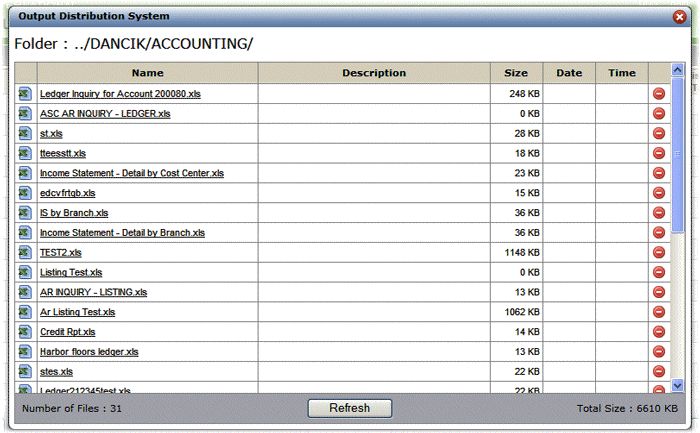
Associated Files
- Access to all Navigator applications can be granted or restricted globally, by authority class, or by user. Global settings (NAV 1) are the initial settings, Authority Class settings (NAV 2) override the global settings, and User settings (NAV 5) override both global and authority class.
- Bank Code File Maintenance - ACT 113 - The bank code displays along with the check number in the Check# column. Example: check W12345 where W is the bank code.
System Processes that Happen when EOM is done
Checking Status of the EOM job
Granting Access
Access is granted at the Authority Class level.
1. On the Navigator menu, select option 2 (NAV 2).
2. Enter a W - Web Apps in the Opt field of the Authority Class you want to work with.
3. Enter a W - Work w/Opts for the Accounting application.
4. Enter a G to grant access to the Accounts Receivable End Of Month functionality.
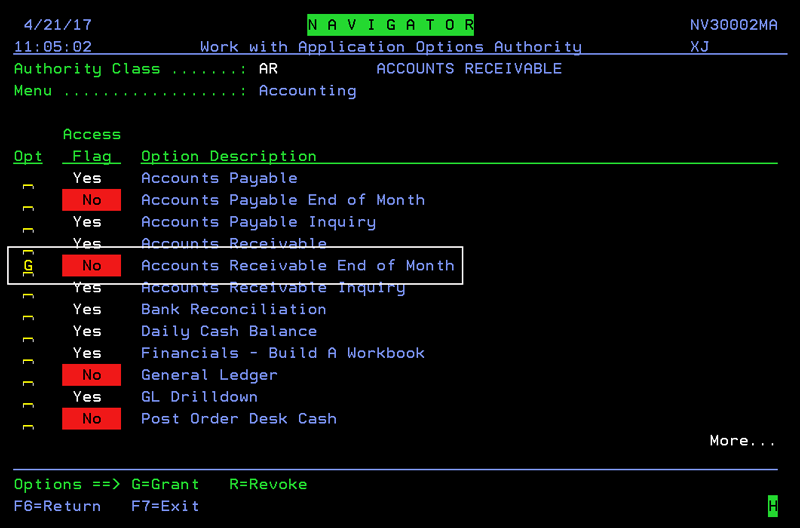
AR End of Month Processes
- Access the Accounts Receivable End of Month application under the Accounting within Navigator.
- The first window to appear lets you start the EOM process.
- Click Run Report to produce a Balance Report. The Balance report checks that the system is in balance.
- Review the Balance Report to ensure AR is ok to update. If it is, check the I have verified the AR Balance Report is in balance box. When the box is checked, the Update AR Balance button becomes active.
- Click Update AR Balance to begin the EOM process for the current month.
- Click Next Step to proceed to Step 2 of the process where we will generate Cash and Sales reports.
- The following Sales Reports are automatically generated:
- AR Monthly Transaction Code Summary - Provides an in-depth analysis and total of each AR transaction code used during the month.
- AR Monthly Transaction Code Summary by Branch - Breaks down the transaction code activity by branch.
- Invoice#s & Other Number Spans Used This Month
- Invoice Register - List all the invoices included in the EOM.
- You can choose to run all, some or none of the following optional reports:
- Monthly Sales by Invoice Date
- Monthly Sales by Transaction Code - This report sorts and sub-totals cash receipts by the transaction codes of the sales transactions the cash was applied to. For example, you can list how much cash was applied against regular invoices, versus direct ships, versus interest charges. If you would like to track how much payment you have received against interest charge invoices, this report shows that figure as the subtotal of transaction code 0X, which is the code for interest or service charges.
- Monthly Audit Report - Sales to other than assigned branch
- Monthly Sales by Customer Account Number
- The following Cash Reports are automatically generated:
- AR Miscellaneous Cash/Acct# 99999 Analysis – Suggested GL Entries
- AR Monthly Cash By Bank Summary
- AR Miscellaneous Cash/Acct# 99999 Analysis – Detail Version
- AR Monthly Cash By Deposit
- You can choose to run all, some or none of the following optional reports:
- Monthly Cash by Payment Date
- Monthly Cash by Payment Transaction Code
- Monthly Cash by Sales Transaction Code
- Monthly Cash by Customer Account Number
- Monthly Audit Report - Cash to Other than Assigned Branch
- Print Addition Copy of Monthly AR Summaries
- Unapplied Advance Deposit Listing
- Click Next Step to proceed Step 3 - Prepare Files.
- A - Update Customer Files with Interest/Service Charges - Accumulated interest charges can be applied to each customer account number. The interest rate comes in from the Mthly Interest Rate % field of the Customer's BillTo File. This option is a memo-only approach, in which monthly statements show the interest amount due, but accounts receivable is only updated when interest is paid.
- If option A is selected, the screen refreshes to ask the question Would you like to print detail list of all past due invoices?
- B - Post Interest/Service Charge as Invoices to AR - This options creates invoices for the accumulated monthly interest charges. The invoice can be sent to each past due account, which is posted to accounts receivable and is tracked just like a regular invoice. If you use Method B, you have the option of running interest program at any time of the month. Therefore, if you run it mid-month, do not run it again now.
- If option B is selected, the screen refreshes to ask the question Would you like to print interÂest/service charges? This report shows each customer's interest rate and new monthly interest charge. You should keep this report, in case you need to show how you arrived at the interest level for an account. Interest is applied only to your choice of Past Due, Over 15, Over 30, or 45-day balance due.
- C - Skip (Interest/Service Charges are Posted Nighty) - Interest/Service Charges are calculated on a per invoice basis, and are charged as soon as an invoice passes its due date. If option C is selected, the screen refreshes to ask the question Would you like to print detail list of all past due invoices?
- Click Next Step to proceed to Step 4 - Print AR Reports.
- AR Aging Report By Company#/Account - sorted by customer account number within the company. Shows only a summary-only one or two printed lines-for each account. The summary includes total balance and an aging breakdown (over 30, over 60, over 90). This report also shows the average age of the AR.
- AR Aging Report By Branch/Customer - sorted alphabetically by customer name within branch. Shows a summary-one or two printed lines-for each account. The summary includes total balance and an aging breakdown (over 30, over 60, over 90).
- Statements and Collection Letters - If your company does not utilize these, you may skip this option. The Billto File Statement Code assigned in the Billto File determines the type of statement the customer receives.
- Ledgers - This option allows you to print a copy of each customer's ledger. The ledgers include a complete current picture of the account, including a list of all open transactions in chronological order and a summary aging into Future, Current, Over 30, and Over 60. In addition, the ledger includes any descriptions or customer PO numbers entered with the sales and customer statistics for current year and previous year.This can be a very lengthy report so if possible save it to a spool file and only print if necessary.
- AR Detailed Aging Report - Shows each open item within each listed account, and ages each item separately. It is strongly recommend that you run this option and save to your spool file. Remember, the system can only run aging reports and capture the aging at a given point in time. Since this is month end, this is a report that you may need to refer back to at later dates, and may be a report requested by auditors.
- Select a Saved Report from the drop down listing for each report.
- Click Next to proceed to the Step 5; the last step of the AR EOM process.
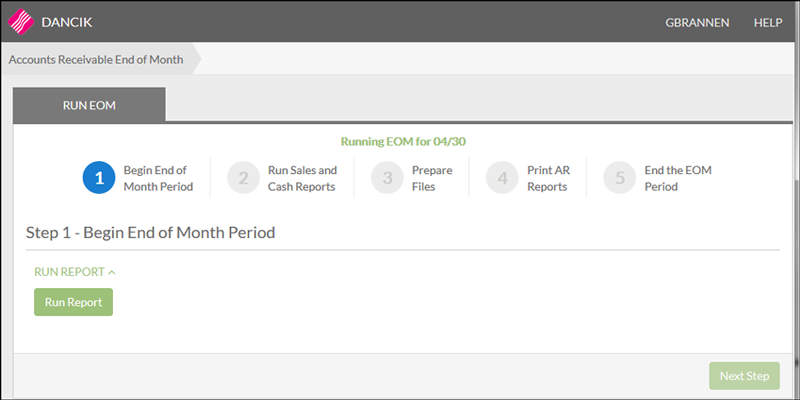
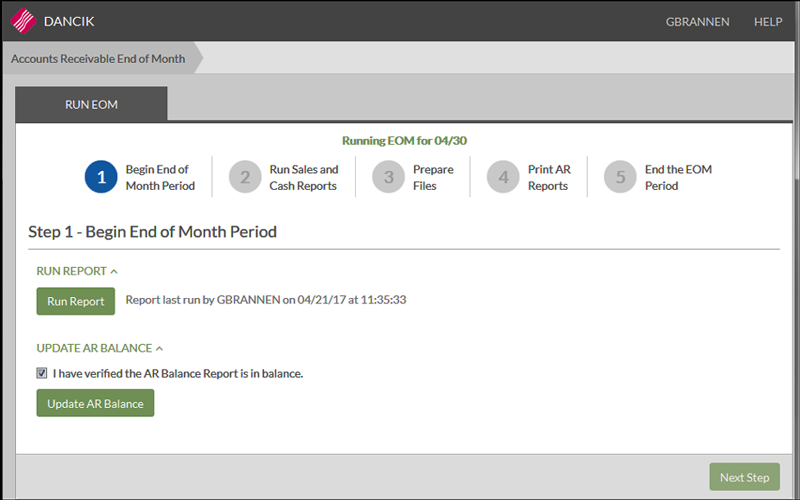
An error message appears when selecting Update AR Balance if AR is out of balance.
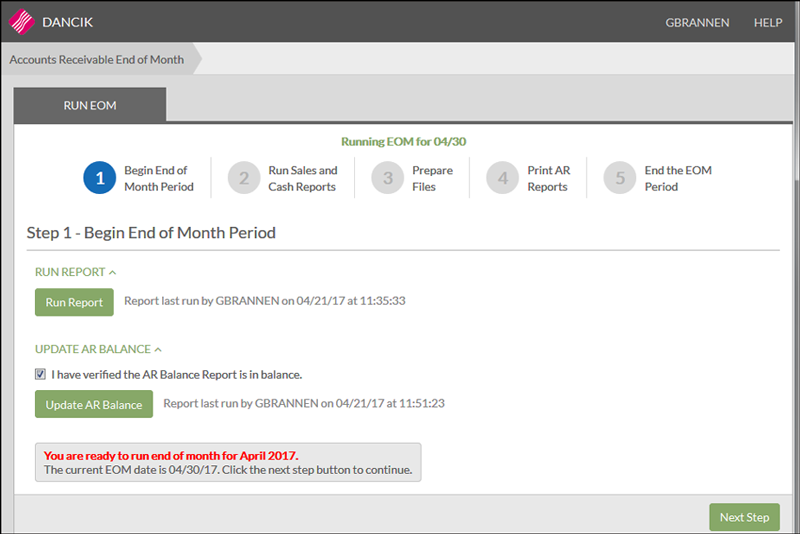
A flag is set on the system that prevents other users from accidentally posting additional information.
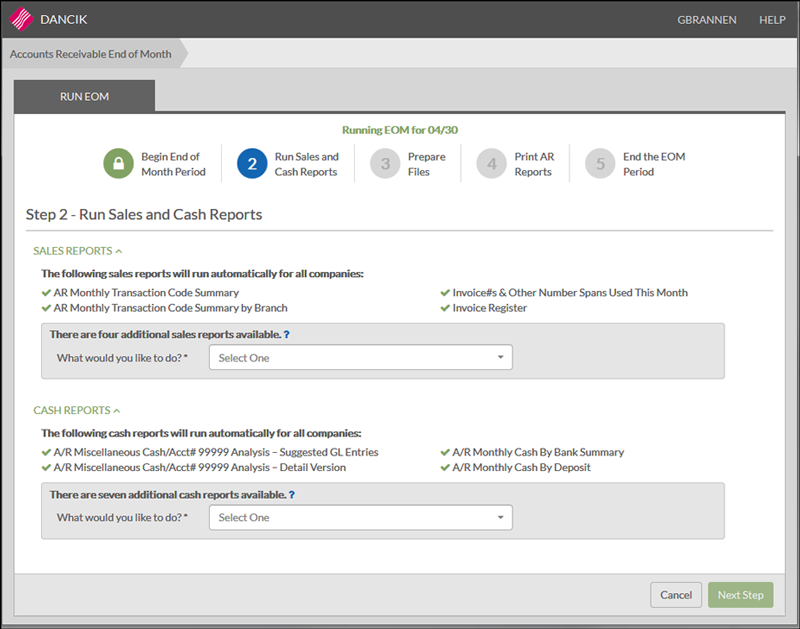
These reports can be run on demand via the AR End-Of-Month Style Cash and AR End-Of-Month Style Sales reports in the Navigator Reporting application.
This step prepares files for the other EOM reports, recalculates aging dates, and optionally assesses interest charges for your system. A report listing the interest charge calculations is generated.
After selecting an aging option for calculating interest/service charges, you can select how you want to apply those charges.
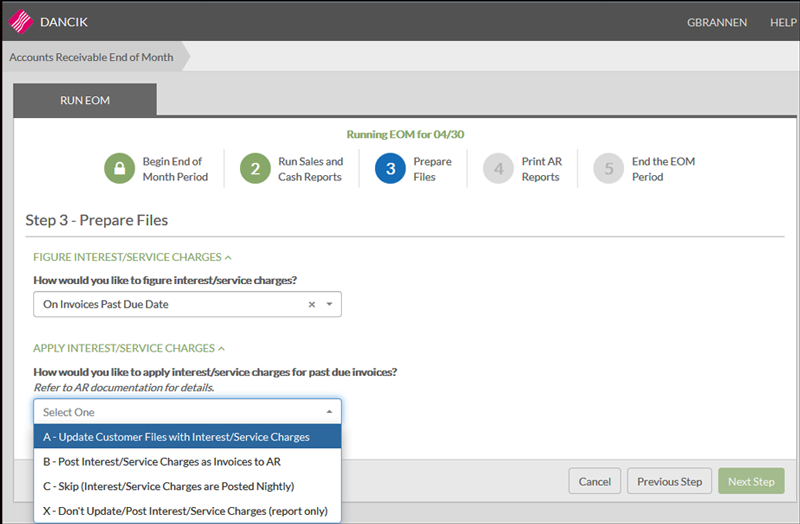
The Apply Interest/Service Charges option determines how to calculate service (interest) charges to the customer accounts. Before running this option, you must be familiar with the aging options set for your system. You must know how your system ages invoices before deciding which options to take. If you will be assessing interest/service charges, you must also know which method to use.
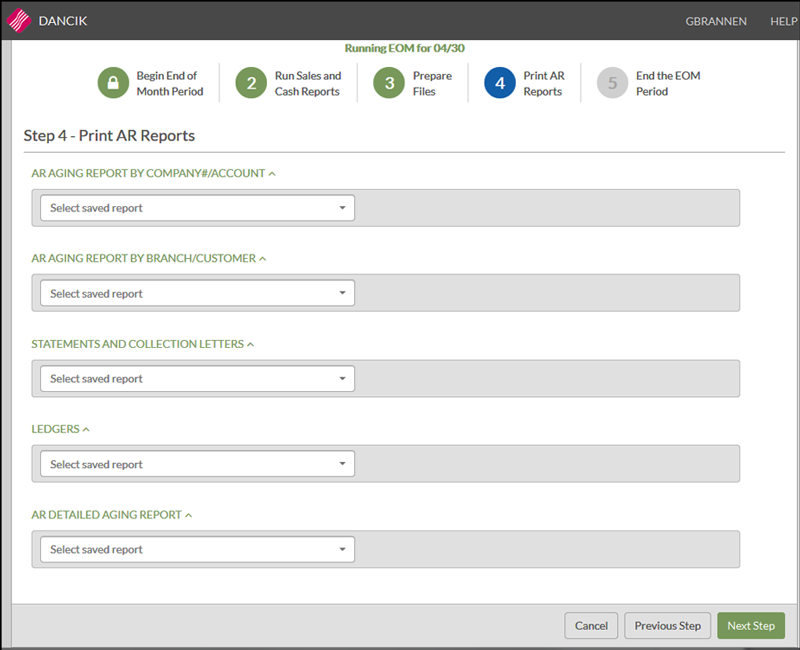
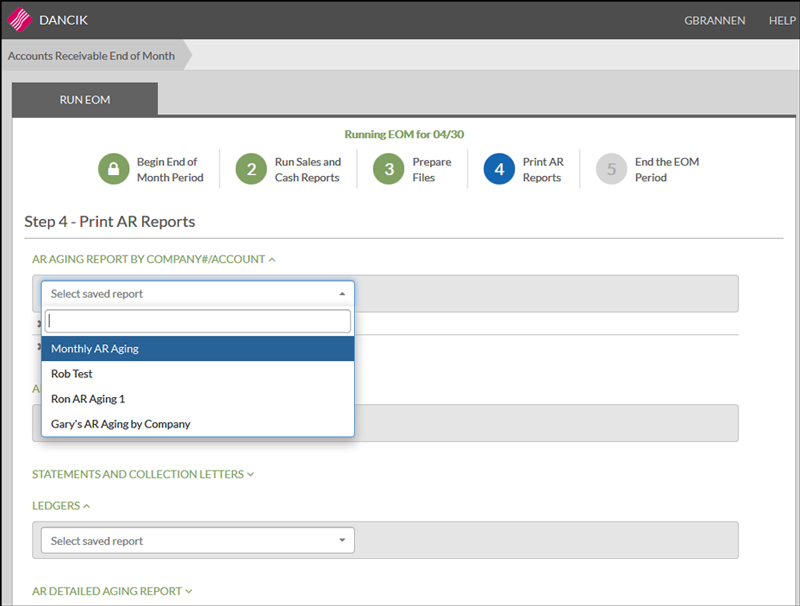
Reports are saved through the Navigator Reports application.
Only Saved reports can be selected and generated. If a saved report is not selected for a report type (i.e. Statements and Collection Letter) no report is generated.
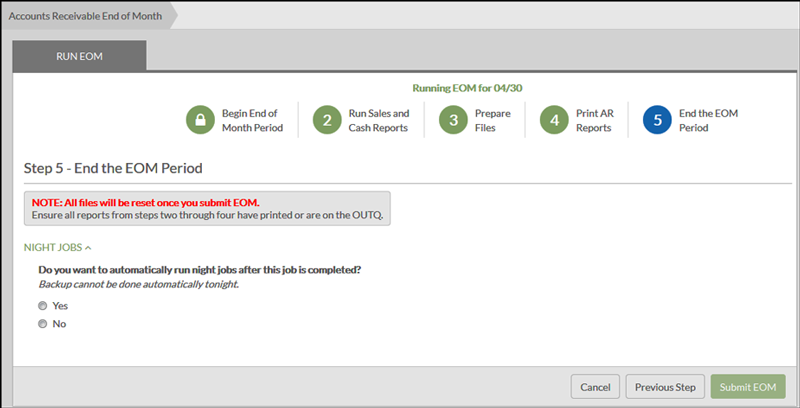
This step actually closes the month and resets all of the A/R files, Order files, and Inventory files for the new month. It also removes old history records. Open transactions are not affected regardless of how old they are. All workstations, except for the one running EOM, must be signed off. Because this step can take a few hours to run, we recommend that you run it at night before running the Night Jobs. Because of the extensive processing and file updates that are run within this step, you should report any power failure or error message immediately.
You can use the Do you want to automatically run night jobs after this job is completed option to automatically run night jobs as part of the final step of your end-of-month procedures.
You should only run EOM and Night Jobs together if your system can finish both jobs before the next business day.
Canceling EOM Process
If the end of month process is canceled and restarted after reports have been created in Steps 2 or 4 it is recommended that the reports be recreated. This is to ensure that the reports match the month end process that was actually completed.
If the end of month process is canceled and restarted after Step 3: Prepare Files for EOM has been performed then you will need to select the Skip Interest/Service Charge Calculation option on the subsequent pass through Step 3 (unless of course you selected that option the first time through the process). This is because Step 3: Prepare Files for EOM updates system files and can cause data issues if it is run more than once (this same issue can occur during the Green Screen End of Month process with menu option EOM 5).
System Processes that Happen when EOM is done
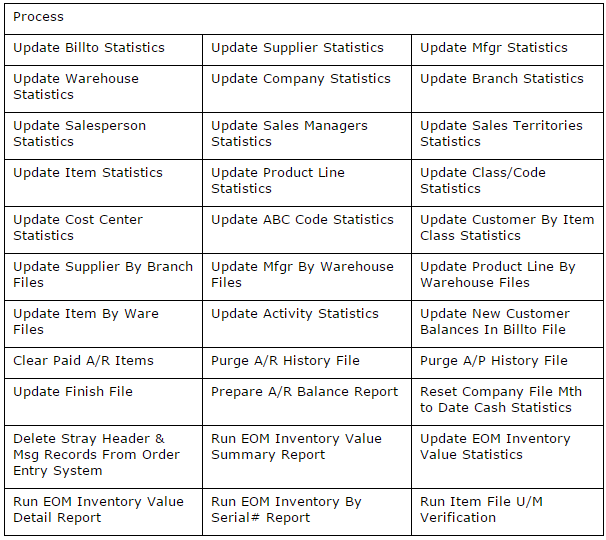
Checking Status of the EOM job
On the Green Screen use the command WRKACTJOB.
Page down until you see the Subsystem Qbatch. You should see the job in a Run Status. You can press the F5 key to refresh the screen and see the job running.
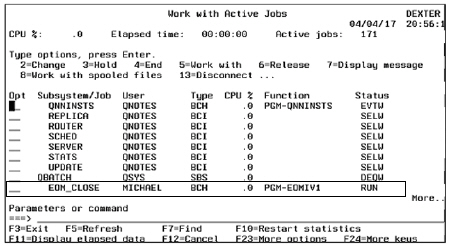
When AR EOM is complete, use the command DSPLOG to see notes in the joblog indicating that this job completed successfully.
Associated Files
- System Wide Settings - Options for Valid AR/AP EOM Date Ranges - This option prevents the entry of an incorrect End-Of-Month date when closing out a month in either the AP or AR systems.
- Company Settings - Option 2 - AR and Credit Options - Contains settings that affect AR.
- Output Distribution System (ODS) - Includes options that allow you to grant or deny the ability to send AR documents. Also included are options to assign fax and email overlays to AR statements.
